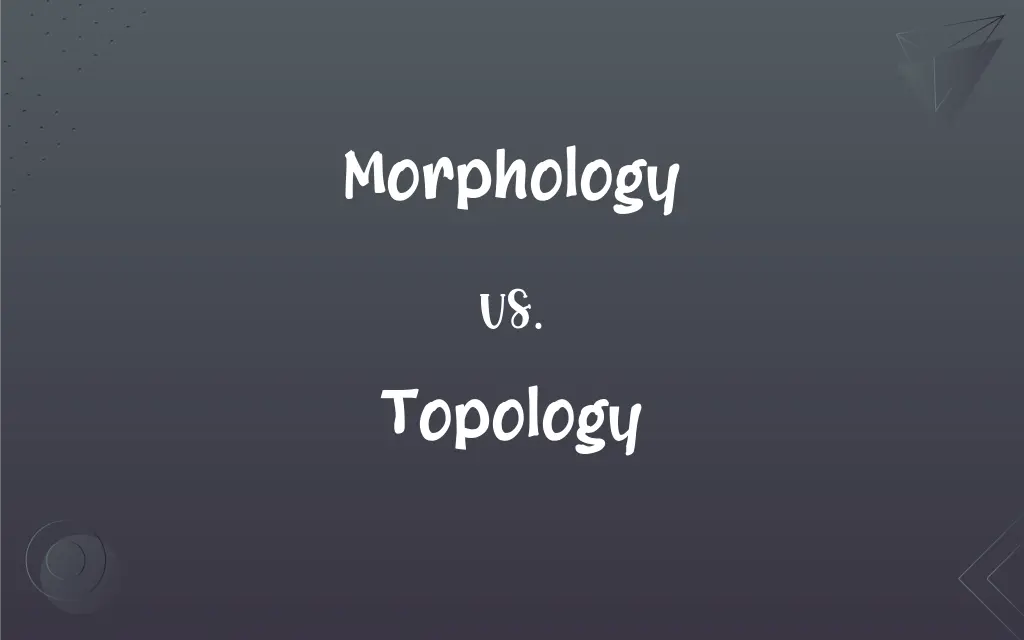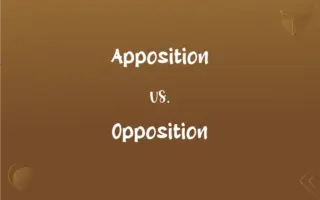Morphology vs. Topology: What's the Difference?
Edited by Aimie Carlson || By Janet White || Updated on October 12, 2023
Morphology refers to the study of forms and structures in organisms or languages, while Topology studies the properties of space preserved under continuous deformations.

Key Differences
Morphology and Topology, at first glance, might appear to be related due to their focus on shapes and structures. Morphology delves into the form, structure, and organization, be it in living organisms or linguistic forms. Topology, on the other hand, delves into properties of space and the very nature of continuity and connectivity.
In the biological context, Morphology examines physical structures of organisms, like the shapes of leaves or anatomy of animals. Topology, in contrast, isn’t as commonly applied in biology, but when it is, it often concerns the properties of complex biological structures and how they can change without tearing or gluing.
Linguistically, Morphology is concerned with the internal structure of words and how they can be modified. Topology doesn't generally have a linguistic application but remains a pivotal concept in mathematics, especially in studying spaces, shapes, and their inherent properties.
One could argue that Morphology is more about "what is seen" in terms of form and structure. Topology, however, delves deeper into abstract concepts, analyzing what can be changed without altering the intrinsic nature of a space.
To summarize, while both Morphology and Topology are concerned with structures and forms, their applications, depth, and perspectives are vastly different, with the former being more tangible and the latter more abstract.
ADVERTISEMENT
Comparison Chart
Primary Focus
Form and structure of organisms or linguistic units.
Properties of space preserved under deformations.
Common Fields
Biology, Linguistics.
Mathematics, Physics.
Tangibility
Often deals with tangible structures.
More abstract and theoretical.
Changes Addressed
Physical or structural changes.
Continuous changes without tearing/gluing.
Key Concepts
Anatomy, word formation.
Homeomorphism, continuity.
ADVERTISEMENT
Morphology and Topology Definitions
Morphology
The study of the form and structure of organisms.
The scientist studied the Morphology of various plants.
Topology
The branch of mathematics involving properties of space preserved under continuous deformations.
In Topology, a donut and a coffee cup are considered equivalent.
Morphology
The branch of linguistics focusing on the structure of words.
Morphology helps explain why run becomes ran in the past tense.
Topology
The way in which constituent parts are interrelated or arranged.
The Topology of the network determined its efficiency.
Morphology
The external structure or form of a living organism.
The Morphology of the butterfly changes dramatically during its lifecycle.
Topology
Topographic study of a given place, especially the history of a region as indicated by its topography.
Morphology
The branch of biology that deals with the form and structure of organisms without consideration of function.
Topology
(Medicine) The anatomical structure of a specific area or part of the body.
Morphology
The form and structure of an organism or one of its parts
The morphology of a cell.
The morphology of vertebrates.
Topology
The study of certain properties that do not change as geometric figures or spaces undergo continuous deformation. These properties include openness, nearness, connectedness, and continuity.
Morphology
(Linguistics) The study of the structure and form of words in language or a language, including inflection, derivation, and the formation of compounds.
Topology
The underlying structure that gives rise to such properties for a given figure or space
The topology of a doughnut and a picture frame are equivalent.
Morphology
(uncountable) A scientific study of form and structure, usually without regard to function. Especially:
Topology
(Computers) The arrangement in which the nodes of a network are connected to each other.
Morphology
(linguistics) The study of the internal structure of morphemes (words and their semantic building blocks).
Topology
The branch of mathematics dealing with those properties of a geometrical object (of arbitrary dimensionality) that are unchanged by continuous deformations (such as stretching, bending, etc., without tearing or gluing).
Morphology
(biology) The study of the form and structure of animals and plants.
Topology
(topology) Any collection τ of subsets of a given set X that contains both the empty set and X, and which is closed under finitary intersections and arbitrary unions.
A set equipped with a topology is called a topological space and denoted .
The subsets of a set which constitute a topology are called the open sets of .
Morphology
(geology) The study of the structure of rocks and landforms.
Topology
(medicine) The anatomical structure of part of the body.
Morphology
(math) Mathematical morphology.
Topology
(computing) The arrangement of nodes in a communications network.
Morphology
(countable) The form and structure of something.
Topology
(technology) The properties of a particular technological embodiment that are not affected by differences in the physical layout or form of its application.
Morphology
(countable) A description of the form and structure of something.
Topology
(topography) The topographical study of geographic locations or given places in relation to their history.
Morphology
That branch of biology which deals with the structure of animals and plants, treating of the forms of organs and describing their varieties, homologies, and metamorphoses. See Tectology, and Promorphology.
Topology
(dated) The art of, or method for, assisting the memory by associating the thing or subject to be remembered with some place.
Morphology
The form and structure of an organism.
Topology
The art of, or method for, assisting the memory by associating the thing or subject to be remembered with some place.
Morphology
The branch of linguistics which studies the patterns by which words are formed from other words, including inflection, compounding, and derivation.
Topology
A branch of mathematics which studies the properties of geometrical forms which retain their identity under certain transformations, such as stretching or twisting, which are homeomorphic. See also topologist.
Morphology
The study of the patterns of inflection of words or word classes in any given language; the study of the patterns in which morphemes combine to form words, and the rules for combination; morphemics; as, the morphology of Spanish verbs; also, the inflection patterns themselves.
Topology
Configuration, especially in three dimensions; - used, e. g. of the configurations taken by macromolecules, such as superhelical DNA.
Morphology
The branch of biology that deals with the structure of animals and plants
Topology
Topographic study of a given place (especially the history of place as indicated by its topography);
Greenland's topology has been shaped by the glaciers of the ice age
Morphology
Studies of the rules for forming admissible words
Topology
The study of anatomy based on regions or divisions of the body and emphasizing the relations between various structures (muscles and nerves and arteries etc.) in that region
Morphology
The admissible arrangement of sounds in words
Topology
The branch of pure mathematics that deals only with the properties of a figure X that hold for every figure into which X can be transformed with a one-to-one correspondence that is continuous in both directions
Morphology
The branch of geology that studies the characteristics and configuration and evolution of rocks and land forms
Topology
The configuration of a communication network
Morphology
The pattern of word formation in a particular language.
English Morphology is different from that of Chinese.
Topology
The study of geometric properties and spatial relations.
Topology helps understand complex structures in higher-dimensional spaces.
Morphology
The study of evolutionary changes in form and structure.
Through Morphology, we understand how birds evolved from dinosaurs.
Topology
The study of concepts like continuity, compactness, and convergence.
She was captivated by the abstract ideas presented in Topology.
Topology
The arrangement of a network, including its nodes and connecting lines.
A bus Topology connects all devices to a single communication line.
FAQs
What's an example of a topic in Morphology?
The formation of plurals in English, like "cat" to "cats".
Is Morphology exclusive to biology?
No, it also has significant applications in linguistics.
What does Topology primarily study?
The properties of space that remain unchanged under continuous deformations.
Is Topology only theoretical?
While abstract, its concepts have practical applications, especially in network design.
Can Topology explain why a coffee cup and a donut are similar?
Yes, they're "homeomorphic" or topologically equivalent.
Can Morphology relate to the study of languages?
Yes, it studies the structure and formation of words.
Does Topology have any relation to maps?
Yes, topological maps represent connectivity, irrespective of actual distances.
Does Morphology study cell structures?
Yes, it includes studying structures at cellular levels.
Is Morphology about physical appearance?
It studies form and structure, which can include physical appearance.
In what field is network Topology important?
It's crucial in computer networking to design efficient systems.
Can Morphology help in evolutionary studies?
Yes, it can trace changes in form and structure over time.
About Author
Written by
Janet WhiteJanet White has been an esteemed writer and blogger for Difference Wiki. Holding a Master's degree in Science and Medical Journalism from the prestigious Boston University, she has consistently demonstrated her expertise and passion for her field. When she's not immersed in her work, Janet relishes her time exercising, delving into a good book, and cherishing moments with friends and family.
Edited by
Aimie CarlsonAimie Carlson, holding a master's degree in English literature, is a fervent English language enthusiast. She lends her writing talents to Difference Wiki, a prominent website that specializes in comparisons, offering readers insightful analyses that both captivate and inform.































































